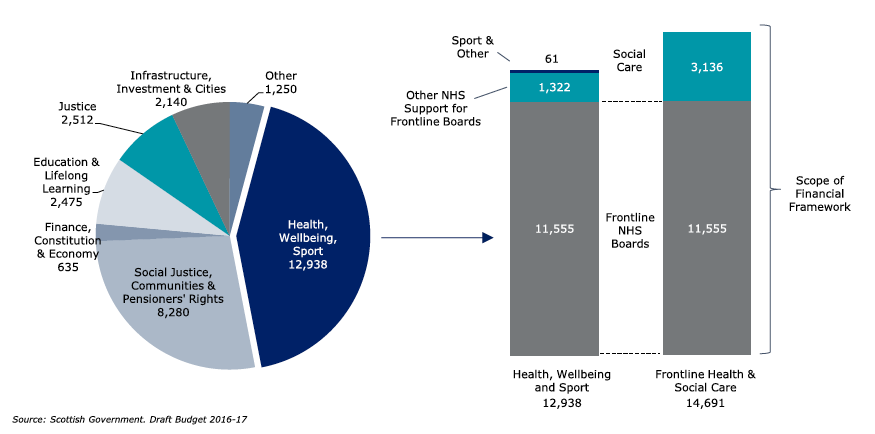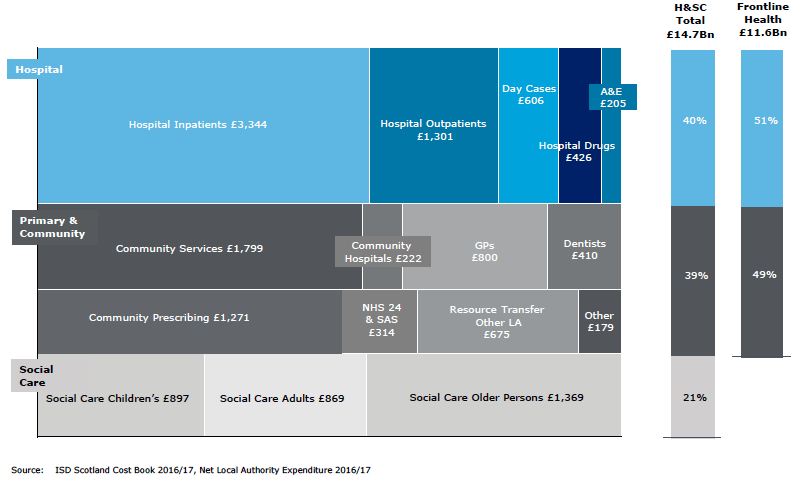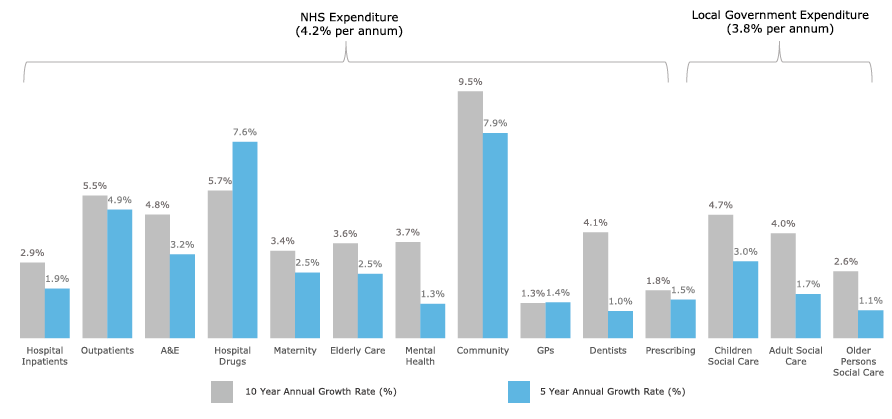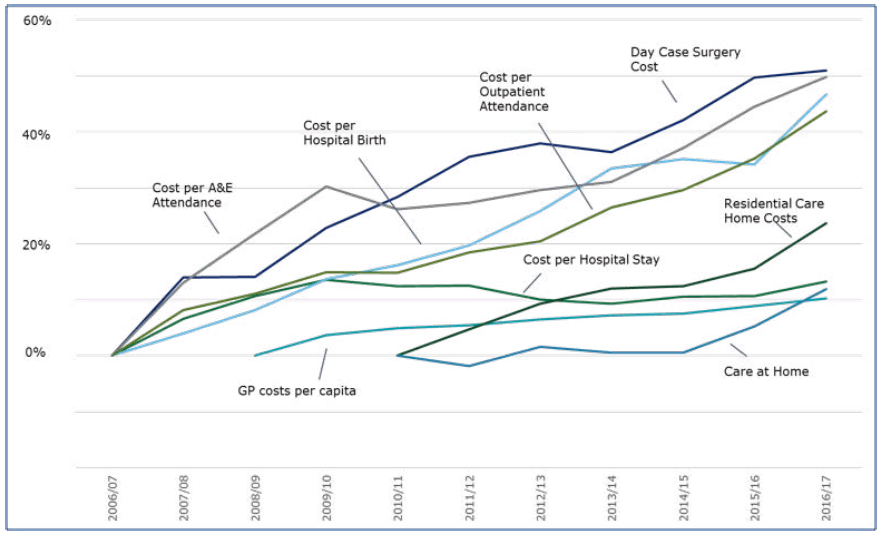Health and Social Care: medium term financial framework
This Framework supports the Health and Social Care Delivery Plan and sets out in more detail the potential approach and type of initiatives required to ensure continued delivery of a financially balanced and sustainable Health and Social Care system.
Health and Social Care Expenditure
Scottish Government Expenditure
The total Scottish Government budget was £30.2 billion[5] in 2016/17, with funding for the Health and Sport portfolio at record levels of £12.9 billion. Health expenditure is the largest component of the Scottish Government’s budget, with spending on the NHS accounting for 43% of total Government expenditure, compared to 37% in 2010/11. Given that there has been a reduction to Scotland’s fiscal budget by 8.4% in real terms between 2010/11 and 2019/20, this proportion is expected to increase in future years due to the protection to health spend, with the Scottish Government’s commitment to increase the health budget by £2 billion over the lifetime of the current parliament and passing on further Barnett resource consequentials arising from the funding settlement for the NHS in England.
The majority of health expenditure is accounted for by the 18 frontline NHS Boards (£11.6 billion), which comprise the 14 territorial NHS Boards, as well as NHS24, the Golden Jubilee Hospital, the State Hospital and the Scottish Ambulance Service. The analysis within this framework document is focused on frontline NHS Board expenditure plus Local Government net expenditure on Social Care (£3.1 billion in 2016/17). Together, this accounts for £14.7 billion in expenditure in 2016/17 on health and social care. More than £8 billion of this total is now managed by 31 Integration Authorities, which have responsibility for commissioning health and social care services for their local populations. Integration Authorities’ budgets are comprised of approximately £5 billion from frontline NHS Boards and £3 billion from Local Authorities.
It should be noted that there is health expenditure delivered through NHS National Services Scotland, Healthcare Improvement Scotland, NHS Education for Scotland and NHS Health Scotland, and also through activity administered centrally within the Scottish Government, including capital expenditure. For the purposes of this document, this expenditure is not included in our analysis.
Figure 1. Scottish Government Revenue Budget 2016/17 (£m)

Figure 2 below illustrates how funding for health and social care is allocated within Scotland following the creation of Integration Authorities.
Figure 2. Health and Social Care Funding Flows in Scotland

Health and Social Care Expenditure
Figure 3 provides an overview of the composition of health and social care expenditure in Scotland in 2016/17. It illustrates that the majority of NHS expenditure is concentrated on the hospital sector (51%), with the largest area of expenditure on inpatient hospital services (£3.3 billion). Areas of significant expenditure include £2 billion spent on community health services (the provision of district nurses, community hospital services and teams), £1.3 billion on the provision of hospital outpatient appointments, £1.3 billion on GP prescribed drugs and a similar amount on social care support for the elderly.
Overall, the NHS budget accounts for approximately 79% of joint health and social care expenditure. Approximately 60% of frontline health board budgets are delegated to Integration Authorities, covering at least adult primary care and most unscheduled adult hospital care. All of adult social care budgets are also included in Integration Authorities’ budgets and some also have responsibility for children’s services.
Figure 3. Health and Social Care Expenditure 2016/17 (£m)

Historical Expenditure Trends
One of the aims of this framework is to provide an estimate of the future resource requirements across health and social care. To provide some context, historical expenditure trends in both health and social care have been examined. NHSScotland and Local Authority expenditure data has been collected in a consistent format for over ten years, and provide some indication of long term trends.[6]
Figure 4 illustrates average annual expenditure growth rates for each major category of health and social care in Scotland from 2006/07 to 2016/17.[7] Overall, NHS expenditure has increased by 4.2%, and social care by 3.8% year on year over the past ten years. However, this rate of growth has slowed in the last five years to 3.2% and 1.8% for the NHS and social care respectively. This largely reflects the real terms reduction in the overall Scottish Government budget as a result of decisions taken by the UK Government, and specifically for Social Care, the use of eligibility criteria to manage resources.
Figure 4. Health and Social Care Historical Expenditure Trends (2006/07 – 2016/17)

Historic trends show a significant increase in the level of community health services spend over the past ten years. Specific policy decisions to invest in community services have contributed to expenditure in this area growing on average by 9.5% year on year.[8] Although we have seen growth in spending on community services, this does not yet represent a shift in the overall balance of care: expenditure on hospital services has also been growing significantly, with high rates of growth in outpatient (5.5%), Accident and Emergency (4.8%) and hospital drug expenditure (5.7%). Expenditure on hospital drugs has increased significantly in the last five years, growing at 7.6% year on year, as new and innovative drugs for cancer and other conditions become more widely available. Expenditure on GP prescribing has shown a slower growth profile over the period, primarily due to a reduction in the price of certain drugs, as well as more generic drugs becoming available to the NHS.
Social care expenditure has also increased in all categories, however in the last five years adult social care spend has risen broadly in line with GDP.
Historical Activity Growth and Trends in Productivity
Over the last few years, activity levels across the health and social care sector have generally increased, particularly in relation to hospital outpatient attendances and elderly care at home hours delivered (Box 1 below). The increase in care at home hours is largely as a raesult of the policy to keep people at home for longer.
Box 1. Activity Levels across Health and Social Care
2.1m (+10%) additional elderly care at home hours delivered from 21.6m in 2010/11 to 23.7m today
1.8m (+21%) additional hospital outpatient attendances from 8.5m per year to 10.3m
140,000 (+17%) additional hospital inpatient cases from 830,000 per year to 970,000
98,000 (+6%) additional A&E attendances from 1.6m per year to 1.7m
67,000 (+16%) additional hospital day cases from 420,000 per year to 490,000
No change in elderly residential care home places since 2010/11 remaining at 30,000 places
5,000 (-5%) fewer inpatient births in Scottish Hospitals from 102,000 to 97,000 episodes per year
There are now 1.8 million more outpatient attendances in Scotland compared to ten years ago whilst most other hospital activity metrics have also increased.
It is also important to consider whether health and social care services are more productive than they were ten years ago. Gains in productivity would mean that health and social care services are delivering more with the money they receive, and increasing productivity will be critical to ensuring the future sustainability of the system. Figure 5 provides an indication of how unit costs have changed over the past ten years based on a selection of available metrics for some of the largest areas of spend.
Figure 5 Unit Cost Growth (%)[10]

This illustrates that unit costs have increased by around 50% over the past ten years for certain hospital services. For example, the cost of an A&E attendance was £82 in 2006/07 and is now £123; likewise an outpatient attendance has increased from £81 to £116 over the same period. The increase in outpatient costs is partly due to the fact that more complex activity is now being done on an outpatient basis than was the case 10 years ago. The increase in A&E attendance costs is partly due to investment in emergency services to support delivery of the four hour target, with the Scottish Government providing specific investment over the last few years to improve capacity and resilience in this area. Inpatient hospital costs have not followed a similar pattern with costs per case only 13% higher over the period, as shorter lengths of stay have enabled hospitals to reduce the number of beds they have needed whilst still seeing more patients. Historically, there is less robust primary and social care data, however, work is underway to provide more of this data. Analysis illustrates that GP costs per capita and care at home unit costs have grown less significantly over the period.
Productivity is complex to assess, particularly within a health and social care context, as activity statistics on their own can often hide other benefits, such as the quality of care. The incline from 2016 in residential care and care at home partly reflects policies relating to the Living Wage.
Summary
Expenditure and activity are at record levels and growth trends across the developed world indicate that the level of funding will only need to increase. However, with greater pressures on the system, this will also require change in the way services are delivered. Many of these initiatives are described in the Health and Social Care Delivery Plan and are being driven forward through the integration of health and social care. Delivering improvements in productivity will also be key, ensuring that high quality services are delivered to the population of Scotland whilst managing within the available resources.
Contact
Health Finance Team:
Health_Finance_Divisional_Support@gov.scot
There is a problem
Thanks for your feedback